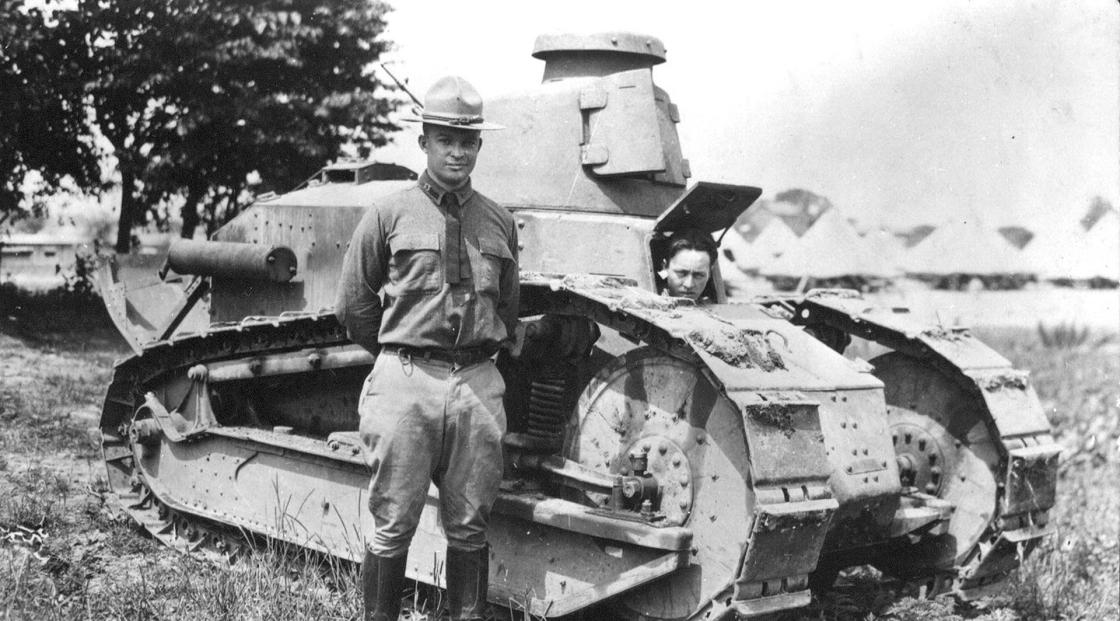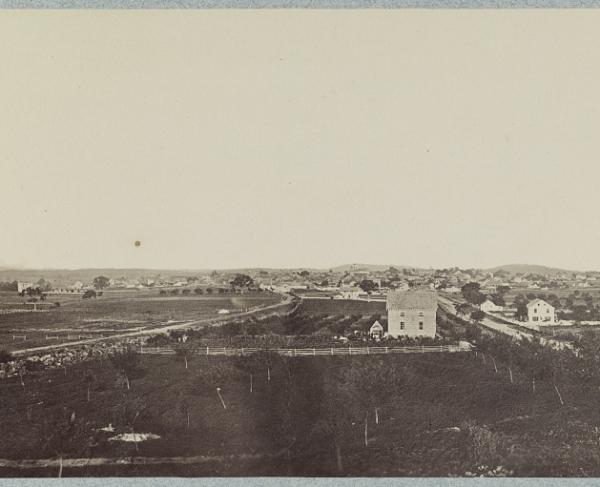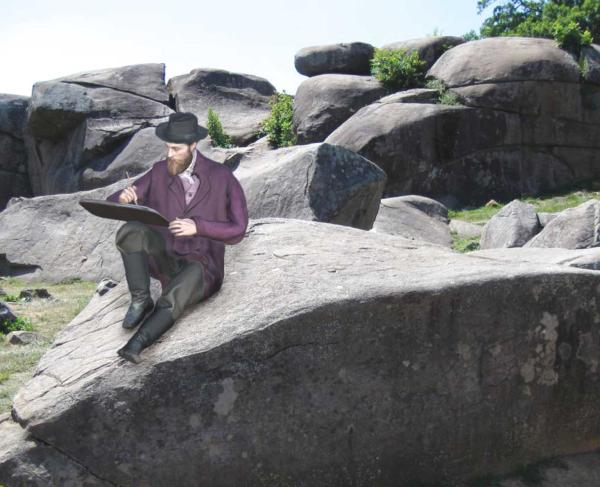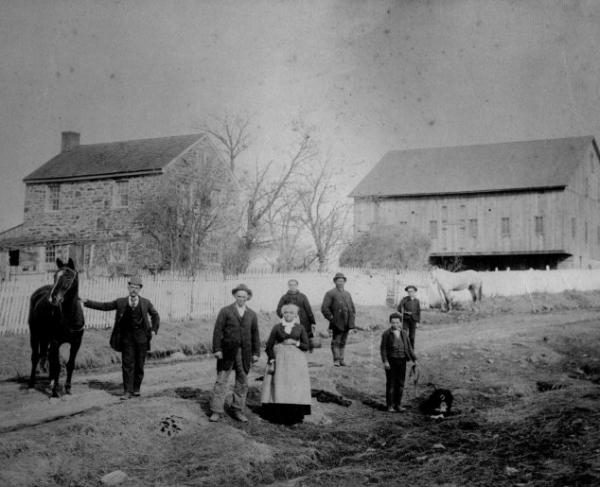“Back in Gettysburg Again”: Dwight D. Eisenhower, A Battlefield & A Farm

Though best-remembered as the Supreme Commander of the Allied Expeditionary Force during World War II and later the 34th President of the United States, Dwight D. Eisenhower also shaped the Gettysburg landscape, battlefield tourism and preservation.
Born on October 14, 1890, in Denison, Texas, Eisenhower grew up with his six brothers in Abilene, Kansas. He developed an interest in military history through his family’s collection of books, later writing:
“I read history for history’s sake, for myself alone…. Had one of our Civil War veterans, for instance, suggested that not many years later, I would visit Gettysburg to study the tactics of the great battlefield where he had fought, my reaction would have been—“Me?” What would have been incredible to me in 1900 did come to pass in 1915. And then three years later I was to be back in Gettysburg again, as the commander of an Army camp. In 1950 I would buy property next to the fields where Pickett’s men had assembled for the assault on Cemetery Ridge.”
Eisenhower attended the United States Military Academy at West Point, graduating in the Class of 1915. West Point provided Eisenhower’s first direct exposure to historic battlegrounds, when in the spring of 1915 his class visited Gettysburg as part of their in-depth study of the battle. Not long after he graduated from West Point, Eisenhower found himself in his first major command, and again, at Gettysburg.
When America entered World War I in April 1917, the United States Army was a fraction of the size of its European counterparts. The first great challenge of the war, therefore, was mobilizing an army that could turn the tide in Europe. As part of the US’s effort to create an army of millions of men, Eisenhower assumed command of Camp Colt, placed atop Cemetery Ridge south of Gettysburg, which served as a training camp for the Tank Corps. Gettysburg National Military Park, as the name implies, was then owned by the War Department, making it an easy place to set up a military post. The camp was furnished with only two tanks, hardly adequate for the thousands of troops expected to train there. Eisenhower oversaw the instruction of the troops in both the classroom and in field exercises using the tanks, traversing the old battleground. While Eisenhower took great care to prepare his men for combat, Eisenhower himself was unable to go to France and fight. He applied multiple times to transfer to the American Expeditionary Force, led by General John Pershing, but was surprisingly denied and assigned to training duties. He still faced a deadly foe of his own, though, in the form of the Spanish Flu, which, if not for Eisenhower’s decisive actions to stop its spread, would have ravaged the camp. Camp Colt, and the town of Gettysburg, were spared the worst of the virus. Many other cramped training camps were not as lucky.

After World War I ended in November 1918, the army once again drastically reduced in size. Eisenhower moved on to other commands. Camp Colt disappeared, having served its purpose, and Eisenhower moved from duty station to duty station filling various roles as a staff officer, including a posting as far away as the Philippines. He slowly rose through the ranks, first to Colonel, then Brigadier General, when in 1941, Japan attacked Pearl Harbor.
General George Marshall tapped Eisenhower to lead America’s first major offensive: Operation Torch, the invasion of North Africa. Eisenhower quickly proved his mettle as a combat commander, leading Allied forces to victory in Morocco, Algeria and Tunisia, then again by leading his forces to victory in Operation Husky: the invasion of Sicily. Eisenhower’s meteoric rise through the ranks in this time as well as his skill in leading his coalition forces convinced Allied leaders to task him with the largest job yet: the invasion of mainland Europe. “Ike,” as he became popularly known, led the preparations for D-Day, soothing tensions between many different personalities and national armies involved. He then oversaw the Allied breakout from Normandy and subsequent liberation of Western Europe. When the war ended, Eisenhower held the highest rank available to an officer at the time, the five-star “General of the Army.”
After World War II, Eisenhower became the president of Columbia University, and shortly thereafter began looking for a quiet spot to retire. His mind returned to Gettysburg, which still held a place in his heart from his days at Camp Colt. He and his wife found a farm which bordered the southwest side of the park, sitting on land where the Confederate divisions of John Bell Hood and Lafayette McLaws assembled to attack the Round Tops, and purchased it as their retirement home. Eisenhower reflected on the decision to eventually settle near Gettysburg, writing: “After all, Gettysburg had been significant in the early years of our married life and our sentimental attachments to it were reinforced by its significance in American, as well as our personal, history.”
However, fate still had much in store for the Eisenhowers before their retirement. The general returned to Europe once more to command NATO forces there, and after that, the Republican Party convinced him to become their nominee for president. Eisenhower beat Harry Truman in the 1952 election and assumed the presidency in 1953.
Throughout his time in the White House Eisenhower spent many of his weekends and holidays at the family farm in Gettysburg, the home becoming a miniature White House in and of itself. The relaxed atmosphere at the farmhouse allowed the President and First Lady to entertain family, close friends and foreign dignitaries in a private setting. Eisenhower wrote about his favorite room in the house:
“At Gettysburg, the important room is a glassed-in porch, not much larger than a modest living room, where we spend hour from early breakfast to late evening. Facing east, with the morning sun brightening it and in shadow through the heat of a summer day, the furnishings casual and designed for comfort, both Mamie and I find it an oasis of relaxation.”
In the enclosed porch and walking or driving around Gettysburg National Military Park, Eisenhower entertained many foreign dignitaries, including Winston Churchill, Charles DeGaulle, Jawaharlal Nehru, and Nikita Kruschev. The historic battlefield provided a setting for quiet discussions about leadership, the Cold War and hopes for peace.

After his two terms as president, Eisenhower finally retired full time to Gettysburg, taking up an office in Gettysburg College to write his memoirs and advise other leaders as an elder statesman. While there, he and his wife donated the farm to the National Park Service for safe-keeping, although they continued to live in the home. Dwight D. Eisenhower died in nearby Washington, D.C., on March 28, 1969, aged 78. Mamie Eisenhower continued to live on the farm until her own death in 1979. The home and the grounds opened to the public for the first time in 1980. Visitors can walk through the rooms of the home, view the barn, learn about the agricultural innovations that Eisenhower practiced and encouraged and even check out the old helicopter land pad in front of the house.
Dwight D. Eisenhower hoped that his farming endeavors would be restoring for the land he had purchased, and he wrote, “there are enough lush fields to assure me that I shall leave the place better than I found it.” Whether it was the farm itself or the surrounded protected battlefield, Eisenhower recognized that “Gettysburg, in fact, was a demonstration of what a tiny portion of nation’s number can accomplish in the shaping and the making of history.” Even as he wrote the next chapters of Gettysburg’s history as a diplomatic site, Eisenhower remembered the Civil War history, pointing out, “Here, indeed, is a lesson against collapse into despair because all things seem lost.” He hoped that his guests and other visitors to the historic area would reflect on the lessons of history embedded in the landscape. “Were they to delve a little deeper into the record of those who fought here, they would find lessons and inspirations beyond price….”
Further Reading:
- At Ease: Stories I Tell To Friends by Dwight D. Eisenhower (1981)
- Eisenhower’s Gettysburg Farm (Images of America) by Michael J. Birkner, Carol A. Hegeman and Kevin Lavery (2017)
Related Battles
23,049
28,063


